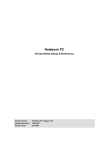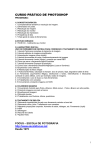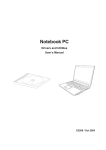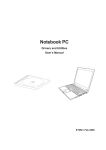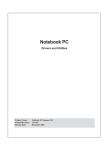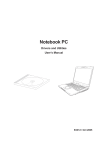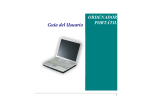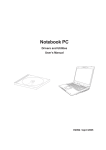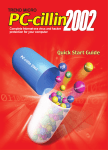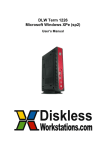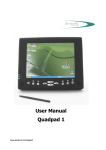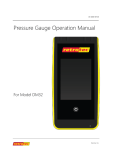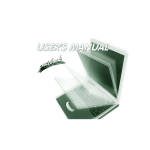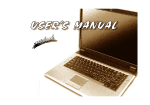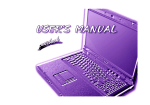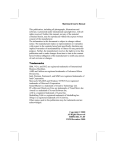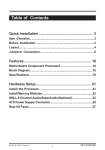Download Notebook PC
Transcript
Notebook PC Driver/Utility Setup and Reference Product Name: Manual Revision: Release Date: Notebook PC Support CD 1.00 E779 Oct 2001 Table of Contents Windows Quick Install Guide .................................................................................................. 4 Support CD for Windows ME and 2000 .................................................................................. 5 Drivers for Windows ME and 2000 .......................................................................................... 5 Autorun Screen for Windows ME ..................................................................................... 5 Autorun Screen for Windows 2000 ................................................................................... 5 Support CD Contents .............................................................................................................. 6 ATKACPI Utility Submenu ....................................................................................................... 8 Autorun Screen for Windows ME ..................................................................................... 8 Autorun Screen for Windows 2000 ................................................................................... 8 VIA INF Update ....................................................................................................................... 9 Installing the VIA INF Update for Windows ME and 2000 ................................................ 9 ATKACPI Driver .................................................................................................................... 10 Installing the ATKACPI Driver for Windows ME .............................................................. 10 Installing the ATKACPI Driver for Windows 2000 ........................................................... 10 AGP Driver ............................................................................................................................ 11 Installing the AGP Driver for Windows 2000 ................................................................... 11 VGA Driver ............................................................................................................................ 12 Installing the VGA Driver for Windows ME ..................................................................... 12 Using Display Properties ................................................................................................ 13 Installing the VGA Driver for Windows 2000 ................................................................... 14 Audio Driver .......................................................................................................................... 15 Installing the Audio Driver for Windows ME and 2000 ................................................... 15 Audio Controls ................................................................................................................ 16 DirectX 8.0 ............................................................................................................................ 17 Installing DirectX 8.0 for Windows ME and 2000 ........................................................... 17 LAN Driver (Required) ........................................................................................................... 18 Installing the LAN Driver for Windows ME and 2000 ..................................................... 18 Joining a Domain (Windows ME) ................................................................................... 19 Joining a Domain (Windows 2000) ................................................................................. 20 Viewing Your Network ..................................................................................................... 21 Modem Driver ........................................................................................................................ 22 Installing the Modem Driver for Windows ME ................................................................. 22 Installing the Modem Driver for Windows 2000 .............................................................. 25 TouchPad .............................................................................................................................. 26 Installing the TouchPad Driver for Windows ME ............................................................. 26 Installing the TouchPad Driver for Windows 2000 .......................................................... 27 2 Table of Contents (Cont’) Fast IR Driver ........................................................................................................................ 29 Installing the Fast IR Driver for Windows ME and 2000 ................................................. 29 Setting the IR port for Windows ME ............................................................................... 30 SpeedStep ............................................................................................................................ 33 Installing SpeedStep for Windows ME and 2000 ........................................................... 33 PC-cillin 2000 ........................................................................................................................ 35 Installing the PC-cillin 2000 Anti-Virus Software for Windows ME ................................. 35 Installing the PC-cillin 2000 Anti-Virus Software for Windows 2000 ............................... 40 Hotkey Utility (Under ATKACPI Utility) .................................................................................. 42 Installing the Hotkey Utility for Windows ME & 2000 ...................................................... 42 Windows Flash Utility (Under ATKACPI Utility) ..................................................................... 43 Installing the Windows Flash Utility for Windows ME & 2000 ........................................ 43 Check Mail Utility (Under ATKACPI Utility) ............................................................................ 44 Installing Check Mail for Windows ME & 2000 ............................................................... 44 IDESwap Utility (Under ATKACPI Utility) .............................................................................. 45 Installing IDE Swap for Windows ME ............................................................................. 45 Windows ME and 2000 Software Reference ..................................................................... 47 3 Windows Quick Install Guide 1. Insert the Windows ME/2000 CD into the CD-ROM drive. 2. ATAPI CD-ROM Drive must be set to boot before the Hard Drive in BIOS setup (press F2 during boot) or press Esc and select “ATAPI CD-ROM Drive” (use the up and down arrows and press Enter) IMPORTANT: In most cases, you will be prompted to press a key to boot from the CD. Failure to do so will result in booting from your next boot device. 3. Press Enter to Setup Windows and press F8 after you have read and accepted the Licensing Agreement. 4. Windows ME: If you have an existing OS, you can choose to install Windows ME in another directory in order to preserve your existing OS. You will be given an OS choice each time you boot up your Notebook PC. If you currently use Windows 95/98 and wish to preserve your installed applications and settings, “upgrade” Windows by installing into your existing directory. Windows 2000: If you have a previous OS, press ESC to install a fresh copy of Windows 2000. Follow the next screens to partition your hard drive. Use the “NTFS” file system for increased functionality. Installing in the same partition as an existing OS will give you a choice to format or leave intact. If you choose leave intact without formatting, you will be given a choice to boot from Windows 2000 or from the previous OS each time you boot up your Notebook PC. 5. After you install Windows, insert the Notebook PC support CD to install drivers and utilities. 4 Support CD for Windows ME and 2000 The Notebook PC you purchased may or may not be preloaded with an operating system. The support CD included with this Notebook PC provides all the necessary drivers and utilities in order for you to use your Notebook PC with Microsoft® Windows® 98/ME/2000 (referred to as “Windows” in this User’s Manual). This Notebook PC offers its customers the choice of a pre-installed operating system such as Microsoft Windows ME (Millennium Edition) or Windows 2000. The choices and languages will depend on the territory. The levels of hardware and software support may vary depending on the installed operating system. Operating systems not pre-installed on this Notebook PC may produce different results than the ones described in the provided user’s manuals. If your Notebook PC is not preloaded with any operating system, or you want to install another operating system other than the preloaded one, the following pages will give step-by-step installation procedures for typical system configurations under the Windows® operating system. For application usage, please see the online help provided with each of the applications after installation. The following is what you will see when you insert the support CD. If the autorun menu does not appear, double clicking the CD-ROM disc drive icon in “My Computer” (may be the (D:) drive or (E:) drive on hard drives with two partitions) or running SETUP.EXE (through Start menu “Run...”) located in the root of the support CD, will bring up the autorun menu. Autorun Screen for Windows ME Autorun Screen for Windows 2000 Drivers for Windows ME and 2000 The following are descriptions of what each autorun menu item does when selected with the mouse. Due to ongoing improvements in the support CD, there may be some differences between this User’s Manual and your support CD. The names in quotations are the actual driver names displayed in the System Properties of MS Windows. Windows cannot contain all the device drivers from every manufacturer, with every update; therefore the provided support CD will contain the best driver for your built-in devices and should be used in place of any Windows default drivers. 5 Support CD Contents VIA INF Update (required) “VIA Tech” Drivers Shown under Windows “System devices.” This installs drivers for the Notebook PC’s specific chipset. ATKACPI Driver (required) “ATK0100 ACPI UTILITY” Driver Shown under Windows “System devices.” This installs drivers for the Notebook PC’s Advanced Configuration and Power Interface (ACPI) for features utilizing power management functions. AGP Driver (required for Windows 2000) Windows 2000 requires an AGP driver for this Notebook PC because the graphics hardware is much newer than what is provided with the operating system. VGA Driver (required) “S3 Graphics Twister” or “S3 Graphics Inc. Twister” Driver Shown under Windows “Display adapters.” This installs display drivers for your operating system in order to properly use the Notebook PC’s built-in graphics controller and to provide optimal features. Once the display driver is installed, you can change your display’s resolution and color through Display Properties. Audio Driver (required) “VIA Audio controller - SigmaTel CODEC” Driver Shown under Windows “Sound, video and game controllers.” This installs audio drivers for your operating system in order to properly use the Notebook PC’s built-in sound controller. All audio functions are configured through Windows and help can be located within Windows documentation or Windows help files. DirectX 8.0 (recommended) (Integrated with Windows) Driver Installs version 8 of the DirectX utility for modern multimedia software applications. Windows uses DirectX to enhance multimedia capabilities on your computer. DirectX provides better playback of different types of multimedia and manages 3-D graphics better than console computers. Most graphics intensive games require DirectX and will include it on their setup CD. LAN Driver (required) “Realtek RTL8139(A/B/C/8130) PCI Fast Ethernet” Driver Located under Windows “Network Adapters.” Installs the required LAN driver for the Notebook PC’s built-in PCI Fast-Ethernet controller. Fast-Ethernet supports both 10 Base-T or 100 Base-TX networks at half or full duplex. Modem Driver (required) “HSP56 World MicroModem” or “HSP56 MR” Driver Installs the necessary driver in order for your operating system to have the correct files for the Notebook PC with built-in modem and drivers for integration with the internal audio. With third-party software, fax and speaker phone capabilities are possible using this Notebook PC. TouchPad (recommended) “Synaptics PS/2 TouchPad” Driver Shown under Windows “Mice and other pointing devices.” Installs “Synaptics® TouchPad” utility. The Notebook PC already supports built-in or externally connected keyboard and PS/2 mouse devices. However, the provided device driver will provide enhancements and features to the TouchPad to increase the functionality of the TouchPad. For detailed information, see the Software Reference in the next section. To access help, right-click the TouchPad icon on the taskbar and select Help. 6 Fast IR Driver (required) “VIA Fast Infrared Controller” Driver Shown under “Network adapters”. Installs driver and configures your Infrared Transceiver A to “HP HSDL2300/3600” so that your Infrared port can work properly. SpeedStep (recommended) Utility Installs Intel® SpeedStep™. SpeedStep™ is a technology that provides adjustable processor speeds for maximum performance when connected to an external power and battery optimized performance when going mobile. The processors can dynamically switch clock frequency and voltage, depending on whether the computer is running on batteries or is plugged into AC power. These changes in frequency happen in only 1/2000th of a second — so fast, they are invisible to users, even if they occur in the middle of performanceintensive applications. PC-cillin 2000 (optional) Utility Installs Trend’s PC-cillin 2000, a world-class anti-virus protection software for the new Internet era, to keep your PC virus-free. This very powerful anti-virus software is bundled with each Notebook PC to protect your investment. As software become more and more a part of our daily lives, measures have to be taken to protect them. You may skip this software if you have your own anti-virus software. ATKACPI Utility (submenu) Link Shows you a sub-menu with additional utilities. These utilities require that you first install the ATKACPI driver. See next page for descriptions of the utilities. Read Me Text Gives you notes concerning this support CD or the Notebook PC. Browse this CD Shows you the contents of this support CD using Windows Explorer. Technical Support Form Text Opens up a Technical Support Request Form so that you will understand what kind of information is needed if you run into problems and require technical assistance. Exit Closes the support CD autorun screen. 7 ATKACPI Utility Submenu Autorun Screen for Windows ME Autorun Screen for Windows 2000 Hotkey Utility (required) Utility Installs Hotkey utility. Hotkey utility is a program designed to intercept key strokes so that key assignments can be made to run a program or script. This program cannot be used to change default keys or key combinations used by other software, operating systems, or by the Notebook PC’s hardware. Windows Flash Utility (recommended) Utility Installs a BIOS update utility for Windows so that you can conveniently update your Notebook PC’s BIOS without having to restart your Notebook PC in DOS mode. Check Mail Utility (optional) Utility Installs ASUS Check Mail Utility to monitor and notify you of incomming email messages waiting in your Microsoft® Outlook or Outlook Express Inbox. (This utility may or may not be compatible with other email applications.) IDE Swap Utility (Required for AiBox in Windows ME) Utility This driver is required for Windows ME but not required for Windows 2000. Installs a Plug & Play utility to monitor the AiBox port and automatically enable the AiBox and module device drivers. This utility is also used to disable the drivers when you want to remove the AiBox or eject a module device. Note: Ejecting a module device requires that you first stop the service and remove the AiBox connector. 8 VIA INF Update VIA INF Update Installing the VIA INF Update for Windows ME and 2000 Installation is the same for Windows ME and 2000. Insert the support CD and click VIA INF Update on the autorun menu to start the installation wizard. (1) Click Next after reading the welcome message. (2) Installation has finished. Select No so that you can install other items and then click Finish. 9 ATKACPI Driver Installing the ATKACPI Driver for Windows ME Installation is the same for Windows ME and 2000 but have different dialog boxes. Insert the support CD and click ATKACPI Driver on the autorun menu to start the installation wizard. ATKACPI Driver (1) Click Yes to begin installation. (2) Installation has finished. Click No so that you can install other items. ATKACPI Driver Installing the ATKACPI Driver for Windows 2000 Installation is the same for Windows ME and 2000 but have different dialog boxes. Insert the support CD and click ATKACPI Driver on the autorun menu to start the installation wizard. (1) Click OK to install the driver. 10 (2) Installation has finished. Select OK to restart your computer. AGP Driver Installing the AGP Driver for Windows 2000 (1) Click OK to begin installation. AGP Driver Installation is not required for Windows ME. Insert the support CD and click AGP Driver on the autorun menu to start the installation wizard. (2) Installation has finished. Click OK to restart your computer. 11 VGA Driver Installing the VGA Driver for Windows ME Installation is different for Windows ME and 2000. Find Windows 2000 after this section. After installing Windows, your screen area will appear smaller than the available display and with poor resolution. Insert the support CD and click VGA Driver on the autorun menu to start the installation wizard. (1) Click Next after reading the welcome message. VGA Driver (3) Installation has finished. Select Yes to restart your computer so that you can use a larger screen area to install other items 12 (2) Click Next after reading the installation information. VGA Driver Installing the VGA Driver for Windows ME (Cont’) Using Display Properties (2) Click the Settings tab VGA Driver (1) Right-click on the Windows desktop and click Properties. (3) Set Colors to True Color and Screen area to 1024 by 768 pixels. NOTE: Setting to larger screen areas will require panning (by moving your cursor to the screen’s border) in order to see the entire desktop. (4) You can select “Apply...without restarting?” and “Don’t ask...again” to save time in the future. Click OK to test your settings. (5) Click Yes to keep your settings. If you click No or are unable to click to Yes, your previous settings will be restored. 13 VGA Driver Installing the VGA Driver for Windows 2000 Installation is different for Windows ME and 2000. Find Windows ME before this section. After installing Windows, your screen area will appear smaller than the available display and with poor resolution. Follow the steps below to correct the problem. (1) Click OK to install the driver. VGA Driver (3) After restart, set the “Screen area” to 1024 by 768 and “Colors” to True Color. Select OK to exit with these settings. 14 (2) Setup has finished. Click OK to retart your computer. Audio Driver Installing the Audio Driver for Windows ME and 2000 Installation is the same for Windows ME and 2000. Insert the support CD and follow the steps below. (1) Click Next to install the driver. (2) Read the license agreement and click OK. VGA Driver Windows ME Windows 2000 (3) Select Install and click OK to install the driver. (4) Setup has finished. Select No and click Finish so that you can install other items and restart later. Win2K: You will not be asked to restart. 15 Audio Controls A Speaker icon will show on the task bar and when selected with the left mouse button. A simple master control will show. If selected with the right mouse button a menu will show allowing adjustment of audio properties or detailed volume controls. Mouse Left-Click Mouse Right-Click Select “Open Volume Controls” or Double Click Speaker Icon Audio Driver 16 DirectX 8.0 Installing DirectX 8.0 for Windows ME and 2000 Installation is the same for Windows ME and 2000. Insert the support CD and click DirectX 8.0 on the autorun menu to start the installation wizard. (1) Click Yes to continue and install DirectX. (2) Click Yes after reading the license agreement. DirectX 8.0 (3) Installation has finished. Click OK to restart your computer. 17 LAN Driver LAN Driver (Required) Installing the LAN Driver for Windows ME and 2000 Installation is similar for Windows ME and 2000. Insert the support CD and click LAN Driver on the autorun menu to start the installation wizard. Windows ME (1) Click Yes to begin installing drivers. (2) Setup has finished. Click No so that you can install other items and restart later. Windows 2000 (1) Click OK to begin installing drivers. 18 (2) Setup has finished. Click OK to restart your computer. LAN Driver Configuring the Network Device Joining a Domain (Windows ME) Use the tabs for other network settings. Double click on the Network driver to make logon settings. Identification is necessary to use the network browser. Enter a workgroup as instructed by your network administrator or try using the name of your domain. All servers may not be visible to you if you do not enter a workgroup that has a primary controller. If you want to log into a server, you must check “Log on...” and enter your domain name. Windows 95/98/ME/2000 all use Windows NT domain. The primary server in the domain will perform routing and login functions for your computer. 19 LAN Driver Configuring the Network Device Joining a Domain (Windows 2000) (1) Right-click the My Computer icon on the desktop and select Properties. (2) Select Network Identification and click Properties. (3) The primary server in the domain will perform routing functions for your computer. Select Domain and enter an existing domain you wish to join. NOTE: After clicking “OK”, you will be asked for the Domain Controller’s Administrator password to join the domain in Windows 2000. 20 LAN Driver Configuring the Network Device Joining a Domain (Windows 2000) (Cont’) (4) Unfortunately, you will have to trouble your network administrator to grant you access. (5) After you restart your computer, you should see some contents through Entire Network. Viewing Your Network (6) Clicking on “entire contents” will display networks which you have installed protocols for. Clicking a network protocol such as “MS Windows Network” will display all the servers available under that protocol. 21 Modem Driver Installing the Modem Driver for Windows ME Installation is different for Windows ME and 2000. Find the Windows 2000 steps after Windows ME. Insert the support CD and follow the steps below to install the modem driver. There is no installation wizard for this process. Modem Driver (1) Right-click “My Computer” and select Properties. (2) Double-click PCI Card to see its properties. (3) Click Reinstall Driver. 22 (4) This installs the first driver. Select “Specify the location...” and click Next. Modem Driver Modem Driver Installing the Modem Driver for Windows ME (Cont’) (5) Enter the path “__\modem\ winme” (with the letter of your CD drive) and click Next. (6) Click Next when the driver is located by Windows. (7) Windows will detect your modem and ask to install the second driver. (8) Enter the path “__\modem\ winme” (with the letter of your CD drive) and click Next. 23 Modem Driver Installing the Modem Driver for Windows ME (Cont’) Modem Driver (9) Click Next when the driver is located by Windows. (10) Click Finish to close the driver installation wizard. (11) Click Close to exit modem properties. 24 Modem Driver Installing the Modem Driver for Windows 2000 Modem Driver Installation is different for Windows ME and 2000. Find the Windows ME steps before Windows 2000 in this manual. Insert the support CD and click Modem Driver on the autorun menu to start the installation wizard. (1) Click OK to begin installing drivers. (2) Setup has finished. Click OK to restart your computer. 25 TouchPad Installing the TouchPad Driver for Windows ME Windows 2000 has different installation steps (see next page). Insert the support CD and click TouchPad on the autorun menu to start the installation wizard. TouchPad (1) Select a language and click OK. (2) Click Next after reading the Welcome message. (3) Browse to another destination folder or click Next to install to the specified directory. (4) Click Next after checking the installation path. (5) Setup has finished. Select No and click Finish so that you can install other items and restart later. 26 TouchPad Installing the TouchPad Driver for Windows 2000 TouchPad Windows ME has different installation steps (see previous page). Insert the support CD and click TouchPad on the autorun menu to start the installation wizard. (1) Choose a language and click OK. (2) Click Next after reading the Welcome message. (3) The TouchPad is integrated into this Notebook PC. Click Next to continue. (4) Click Next after verifying the installation path. 27 TouchPad Installing the TouchPad Driver for Windows 2000 (Cont’) TouchPad (4) Click Yes to accept the driver because the driver on this support CD has been fully tested by the manufacturer to work correctly with MS Windows. You may have to answer this question a second time. (+) After you restart, you will get a “splash” screen that will give you easy access to “Synaptics TouchPad Help” by clicking on the “Tell me more...” button. Deselect the “Show...” to disable this from showing on every Windows startup. 28 (5) Installation has finished. Select No so that you can install other items and then click Finish. Fast IR Driver Installing the Fast IR Driver for Windows ME and 2000 Installation is different for Windows ME and 2000. Setting the IR port (Windows 2000) Insert the support CD and click Fast IR Driver on the autorun menu to make the setting as shown by the dialog box. (2) Setup is complete. Click No so that you can install other drivers and restart your computer later. Fast IR Driver (1) Click OK to install the driver. 29 Fast IR Driver Setting the IR port for Windows ME Insert the support CD but clicking Fast IR Driver only brings up a readme file for the following procedure: Fast IR Driver 30 (1) Double-click Unknown Device under “Other Devices” in “Device Manager”. (2) Click Reinstall Driver to install the driver. (3) Select “Specify...” and click Next. (4) Browse to the “FIR” path for your operating system and click Next. Fast IR Driver Setting the IR port for Windows ME (Cont’) (6) The update has finished. Click Finish to exit. Fast IR Driver (5) Click Next when Windows finds the driver INF file on the support CD. (7) Do not restart your computer. Click No. (9) Infrared Serial (COM) Port will be automatically installed. (8) Click Close to exit the IrDA properties. 31 Fast IR Driver Setting the IR port for Windows ME (Cont’) Fast IR Driver 32 (11) Right-click “My Network Places” on the desktop and select Properties. (12) Double click Fast Infrared Controller. (13) Click Advanced tab and select HP HSDL-2300/ 3600 for “Infrared Transceiver A” and click OK. (14) Click OK to close Network configuration. SpeedStep Installing SpeedStep for Windows ME and 2000 Installation is the same for Windows ME and 2000. Insert the support CD and click SPEEDSTEP on the autorun menu to start the installation wizard. (2) Click Yes after reading the license agreement. SpeedStep (1) Click Next after reading the welcome message. (3) Installation has finished. Select “No...” and click Finish to so that you can install other items and restart your computer later. 33 34 PC-cillin 2000 Installing the PC-cillin 2000 Anti-Virus Software for Windows ME Installation is different for Windows ME and 2000. The following are steps for Windows ME. Insert the support CD and click PC-cillin 2000 on the autorun menu to start the installation wizard. (2) Click Yes after reading the “Agreement”. (+) Wait while your system is scanned for viruses. (4) Enter your “Name” and “Company” (if relevant) and click Next. PC-cillin 2000 (1) Click Next to begin the installation wizard. 35 PC-cillin 2000 Installing the PC-cillin 2000 for Windows ME (Cont’) (3) Wait while your setup checks your system for viruses based on the included pattern file. (This is usually older than what is available on the Internet at “http://www.trend.com”. You should rescan your hard drives after updating the virus pattern.) Click OK when completed. (5) Choose another destination folder or click Next to use the default. PC-cillin 2000 (6) Choose another folder, create a new folder, or click Next to use the default folder for the program icons. 36 (7) Make Internet and Desktop settings and click Next to continue. PC-cillin 2000 Installing the PC-cillin 2000 for Windows ME (Cont’) (9) Check the installation settings and click Next to continue. PC-cillin 2000 (8) Make proxy settings if necessary and click OK to continue. (+) The next step will require a floppy disk drive in order to create rescue disks. If you don’t have one, a warning will be given and the rescue disk wizard will be skipped. If you have a floppy disk drive later, you can create rescue disks from the program. (10)You will be asked to create either complete rescue disks or virus pattern disks. Select one and click Next. Click Cancel to skip to “Setup Complete”. 37 PC-cillin 2000 Installing the PC-cillin 2000 for Windows ME (Cont’) (11)Select a target floppy disk drive and click Next. (13)You will be asked to repeat this step four times if you chose the “Complete Rescue Disk Set”. PC-cillin 2000 (15)Click Finish when the setup is complete. (12)You will be asked to format your floppy disk. Use Quick (or Full if necessary) and click Start. Click Close when format is completed. If you chose the full rescue disks, you have to repeat this step four times. 38 PC-cillin 2000 (14)Click Finish when the “Rescue Disks” are created. (16)Enter your “Name” and “Email Address” to register PC-cillin software. (17)Click Yes to update PC-cillin’s program and virus pattern files. (18)Be patient while your computer connects to the Internet and download necessary files. PC-cillin 2000 Installing the PC-cillin 2000 for Windows ME (Cont’) (19)You can answer No and Cancel so that you can install other drivers then restart your computer later. 39 PC-cillin 2000 Installing the PC-cillin 2000 Anti-Virus Software for Windows 2000 Installation is different for Windows ME and 2000. The following are steps for Windows 2000. Insert the support CD and click PC-cillin 2000 on the autorun menu to start the installation wizard. (1) Click Next after reading the welcome message. (2) Click Next after reading the license agreement. PC-cillin 2000 (3) Wait while your setup checks your system for viruses based on the included pattern file. (This is usually older than what is available on the Internet at “http://www.trend.com”. You should rescan your hard drives after updating the virus pattern.) This screen will change when completed. 40 (4) Enter your “User Name” and “Organization” if applicable. Click Next to continue. PC-cillin 2000 Installing the PC-cillin 2000 for Windows ME (Cont’) (+) Wait while installation takes place. (6) Click Install now or click Back to make changes to the installation settings. PC-cillin 2000 (5) Change the destination folder or click Next to install to the specified directory. (7) Installation has finished. Select Finish to exit the installation wizard. No restart is necessary. * An icon will be placed in your taskbar to show protection status and allow quick access to the PC-cillin software settings. Right-click the icon for quick software settings. 41 Hotkey Utility (Under ATKACPI Utility) Installing the Hotkey Utility for Windows ME & 2000 Installation is the same for Windows ME and 2000. Insert the support CD and click Hotkey Utility on the autorun menu to start the installation wizard. Hotkey Utility 42 (1) Click Next after reading the welcome message. (2) Choose another destination folder or click Next to use the default. (3) Choose another folder, create a new folder, or click Next to use the default folder for the program icons. (4) Click Finish to exit the installation wizard and execute the selections. You can deselect the check boxes before clicking Finish if you want. Flash Utility Windows Flash Utility (Under ATKACPI Utility) Installing the Windows Flash Utility for Windows ME & 2000 Installation is the same for Windows ME and 2000. Insert the support CD and click Windows Flash Utility on the autorun menu to start the installation wizard. (1) Click Next on the “Welcome” screen. (3) Choose another folder, create a new folder, or click Next to use the default folder for the program icons. (2) Choose another destination folder or click Next to use the default. (4) Installation has finished. Select “No...” and click Finish to so that you can install other items and restart your computer later. 43 Check Mail Utility (Under ATKACPI Utility) Installing Check Mail for Windows ME & 2000 Installation is the same for Windows ME and 2000. Insert the support CD and click Check Mail Utility on the autorun menu to start the installation wizard. Check Mail Utility 44 (1) Click Next after reading the welcome message. (2) Choose another destination folder or click Next to use the default. (3) Choose another folder, create a new folder, or click Next to use the default folder for the program icons. (4) Installation has finished. Deselect “...restart my computer now.” and click Finish so that you can install other items and restart your computer later. IDESwap Utility (Under ATKACPI Utility) Installing IDE Swap for Windows ME IDESwap Utility Installation is not required for Windows 2000. Insert the support CD and click IDESwap Utility on the autorun menu to start the installation wizard. (1) Click Next after reading the welcome message. (2) Choose another destination folder or click Next to use the default. (3) Choose another folder, create a new folder, or click Next to use the default folder for the program icons. (4) Installation has finished. Deselect “...restart my computer now.” and click Finish to so that you can install other items and restart your computer later. 45 46 Notebook PC Software Reference Windows ME & 2000 Contents VGA Driver .................................................................................................. 51 Display Settings for Windows ME and 2000 ......................................................................... 52 Display Properties .......................................................................................................... 52 S3Display ....................................................................................................................... 52 S3Gamma Plus .............................................................................................................. 52 Display Properties .......................................................................................................... 53 S3Info Plus ..................................................................................................................... 53 Monitor ............................................................................................................................ 53 Setting First Monitor Type ............................................................................................... 54 Setting Second Monitor Type ......................................................................................... 55 Synaptics TouchPad .................................................................................. 57 Overview of Synaptics® TouchPad Features ........................................................................ 58 Tap on the Pad Instead of Pressing the Buttons ............................................................ 58 Drag Icons, Windows and Other Objects without Using Buttons ................................... 58 Adjust the Overall Touch Sensitivity ............................................................................... 59 Customize Buttons and Taps .......................................................................................... 59 Prevent Accidental Pointing While Typing ...................................................................... 60 Scroll Through A Document without Using Scroll Bars ................................................... 60 Zoom In/Out and Pan on Documents ............................................................................. 60 Move the Pointer Long Distances .................................................................................. 61 Fine Tune the Pointer Movement ................................................................................... 61 Accessories .................................................................................................................... 61 More About the TouchPad .............................................................................................. 61 Property Pages ..................................................................................................................... 61 Scrolling Properties Page ............................................................................................... 62 Tap Zones Properties Pages .......................................................................................... 63 More Features Properties Page ..................................................................................... 64 Button Actions Properties Page ...................................................................................... 65 Touch Properties Page ................................................................................................... 66 Edge Motion Properties Page ........................................................................................ 67 Frequently Asked Questions ................................................................................................. 68 SpeedStep ................................................................................................... 71 Intel® SpeedStep™ Overview .............................................................................................. 72 How it Works .................................................................................................................. 72 IT Friendly ....................................................................................................................... 73 Summary ........................................................................................................................ 73 SpeedStep Properties and Settings ...................................................................................... 74 48 SpeedStep Software Notes ................................................................................................... 76 WARNING ...................................................................................................................... 76 The User Interface .......................................................................................................... 76 Restricted User limitations .............................................................................................. 76 Over-installing ................................................................................................................. 76 Uninstalling the Applet .................................................................................................... 76 PC-cillin 2000 .............................................................................................. 77 Welcome to PC-cillin ............................................................................................................. 78 What’s New in PC-cillin 2000 ......................................................................................... 79 What is a Computer Virus? ............................................................................................. 80 Test Virus ........................................................................................................................ 80 How Viruses Spread ....................................................................................................... 81 Virus Writers ................................................................................................................... 81 Hotkey Utility .............................................................................................. 83 Hotkey Utility ......................................................................................................................... 84 Buttons ........................................................................................................................... 84 Hotkey Actions ................................................................................................................ 85 Adding a Program to Run ............................................................................................... 88 Windows Flash Utility (WINFLASH) .......................................................... 89 Updating Your BIOS ....................................................................................................... 90 Resetting Your BIOS ...................................................................................................... 90 Check Mail Utility ....................................................................................... 91 Check Mail Quick Setup ........................................................................................................ 92 Check Mail Startup ......................................................................................................... 92 Using Windows Start Menu ............................................................................................ 92 Using MS Configuration.................................................................................................. 92 IDE Swap Utility .......................................................................................... 93 IDE Swap Introduction .......................................................................................................... 94 Using the AiBox .............................................................................................................. 94 Stopping the AiBox Before Removing (Windows ME) .................................................... 94 Stopping the AiBox Before Removing (Windows 2000) ................................................. 95 APPENDIX ................................................................................................... 97 Modem Communication Regulations .................................................................................... 97 FCC Regulations ............................................................................................................ 97 FCC Part 68 Requirements ............................................................................................ 97 Modem Declaration Of Conformity ................................................................................. 98 Canadian Department Of Communications (CDOC): ..................................................... 98 49 50 VGA Driver Topics Covered: Display Properties Display Settings Windows ME & 2000 51 VGA Driver Display Settings for Windows ME and 2000 Display Properties S3Display The “S3Display” settings allow you to select or deselect the output display devices. By default the Notebook’s own LCD is Enabled. When a CRT compatible devices is detected on the 15pin VGA connector, the CRT selection will also be checked. NOTE: The function keys on the keyboard will also check or uncheck these selections. S3Gamma Plus Use the “S3Gamma Plus” settings to change Gamma, Brightness, or Contrast for RGB colors separately or together (link). Change the calibration image to display other background images to help you adjust these settings. When you are satisfied with the settings, click OK to save and exit. To save multiple settings: Click Save as and type in a name for the setting. You can repeat the process for other settings and select the different “Schemes” at a later time. Reset to factory settings: Click the Default button. 52 VGA Driver Display Settings for Windows ME and 2000 (Cont’) Display Properties S3Info Plus The S3Info Plus page gives information on your “System configuration”, “S3 Driver”, and “DirectX” version. Monitor The “Monitor” page allows you to see the “Monitor Type”. By default, all detected monitors show “Default Monitor”. You may change this by selecting the “Monitor Type” and clicking Properties to change its driver. 53 VGA Driver Display Settings for Windows ME and 2000 (Cont’) Setting First Monitor Type (1) Select the first Default Monitor and click Properties. (3) Click Next to install the driver for the selected monitor. (2) Select your monitor’s manufacturer and model and click Next. (4) Setup is complete. Click Finish to exit the installation wizard. 54 (5) Click Close to close monitor properties. Monitor type will still show “Default Monitor” until you close and re-enter Monitor Properties page. VGA Driver Display Settings for Windows ME and 2000 (Cont’) Setting Second Monitor Type (6) Repeat this process for the second Default Monitor (7) Click Next to install the driver for the selected monitor. (7) Select your monitor’s manufacturer and model and click Next. (6) Setup is complete. Click Finish to exit the installation wizard. (7) Click Close to close monitor properties. Monitor type will still show “Default Monitor” until you close and re-enter Monitor Properties page. 55 56 Synaptics TouchPad TouchPad Topics Covered: Overview of the TouchPad Scrolling Properties Page Tap Zones Properties Page More Features Properties Page Button Actions Properties Page Touch Properties Page Edge Motion Properties Page Frequently Asked Questions Windows ME & 2000 57 Overview of Synaptics® TouchPad Features Your Synaptics TouchPad is much more powerful than an old-fashioned mouse. In addition to providing all the features of an ordinary mouse, your TouchPad allows you to: TouchPad • • • • • • • • • Tap on the Pad Instead of Pressing the Buttons Drag Icons, Windows and Other Objects without Using Buttons Adjust the Overall Touch Sensitivity Customize Buttons and Taps Prevent Accidental Pointing While Typing (also known as Palm Check) Scroll Through a Document Without Using Scroll Bars Zoom In/Out and Pan on Documents Move the Pointer Long Distances Fine Tune the Pointer Movement Tap on the Pad Instead of Pressing the Buttons Tapping on the surface of the pad is the same as clicking the left mouse or TouchPad button (i.e. the primary TouchPad button). Tapping is usually quicker and more convenient than using the button. To double-click, just tap twice. A light, quick tap works best; very hard or very slow taps are less likely to work. Drag Icons, Windows and Other Objects without Using Buttons Often, you need to hold the mouse or TouchPad button down while moving the pointer (to move an icon or window around the screen, for example). This action is called dragging. Just like clicking and double clicking, you can also drag without using the button. To move or drag an object (equivalent to pressing and holding the left TouchPad button): 1) Position the pointer over the object and tap twice, down-up-down, leaving your finger on the TouchPad on the second tap. This action is sometimes called tap-and-a-half. 2) Now move the selected object by sliding your finger across the TouchPad surface. 3) Lift your finger to drop the object. Tap-and-a-Half You might wonder what happens when you reach the edge of the pad and you are dragging an object. The Synaptics TouchPad has a feature called Locking Drags. This feature allows you to lift your finger from the pad without ending the drag. You can drag an object across the screen using several finger strokes. To end a Locking Drag action, tap again. The Synaptics TouchPad also has a feature called Edge Motion to help with long distance dragging. See Move the Pointer Long Distances for details. The Tap and Drag and Locking Drags features are located on the Touch Properties Page in the Mouse Properties dialog. 58 Adjust the Overall Touch Sensitivity You can control how much finger pressure you must apply before the TouchPad responds by adjusting the Touch Sensitivity slider. This slider is located on the Touch Properties Page in the Mouse Properties dialog. At higher (more sensitive) Touch Sensitivity settings, the TouchPad recognizes even a very slight touch. If you see undesired or erratic pointer motion, try a lower setting. Lower (less sensitive) settings require a firmer touch to move the pointer. In general, a lighter touch works best. TouchPad Customize Buttons and Taps Most TouchPads come with two buttons that work just like traditional mouse buttons. You can customize the behavior of these buttons. Tapping on the TouchPad surface also performs the same action as pressing a button. Tapping in the center of the pad will always produce a left-click (the action of the primary button), but you can configure each of the four corners of the TouchPad surface to act as different buttons. These special corner regions are called tap zones . With four corner tap zones, the center of the TouchPad, and the two physical buttons you can turn your TouchPad into a seven-button mouse! A customization example: Suppose you want to use your TouchPad like a three-button mouse. You can configure the left TouchPad button to produce middle clicks when pressed. Remember that tapping on the TouchPad will produce left clicks, and pressing the right TouchPad button will produce right clicks. For additional convenience, you can configure the top right corner tap zone of the TouchPad to produce right clicks. Looking at the TouchPad surface in the picture below, taps in the top right corner (the red shaded area) will produce right clicks, but tapping anywhere else on the TouchPad (the solid gray area) produces left clicks. An Example TouchPad There are many different actions that you can assign to the buttons and tap zones. The following actions are provided as built-in features with the Synaptics TouchPad device driver. Additional actions might be available if you have installed any third-party TouchPad Plug-In software. • Jump to the Start Button. This action causes the pointer to jump to the Start button in the Windows task bar and automatically opens the Start Menu. • Jump to the current application’s menu. This action causes the pointer to jump to the leftmost entry in the application’s window menu (usually the File menu) and automatically pops up the submenu. • Minimize the current application. This action minimizes the current application’s window. If the current application’s window is already minimized, this action will restore it to its normal size and location. • Maximize the current application. This action maximizes the current application’s window (expands it to cover the full screen). If the current application’s window is already maximized, this action will restore it to its normal size and location. • Run a program of your choosing. This action allows you to specify the name of any program you want to run automatically when you click the button or tap in the tap zone. To customize taps and buttons, go to the Button Actions Properties Page in the Mouse Properties dialog. 59 Prevent Accidental Pointing While Typing Unintentional pointer movement and accidental taps can be caused by accidentally brushing the surface of the TouchPad with your palm or another part of your hand. The results of this contact can be observed as a changing cursor location when typing, causing subsequent text to appear in the wrong place. Or text may “spontaneously” be highlighted and replaced. Most often, this unwanted pointing activity occurs when typing on the keyboard. The TouchPad can detect and prevent accidental and unwanted pointer movement while you are typing. TouchPad If you see unwanted pointer movement occurring while you are typing, you can adjust the Palm Check slider located on the Touch Properties Page in the Mouse Properties dialog. Move the slider thumb to the right towards Maximum. Now accidental brushes of your hand on the TouchPad while you are typing are more likely to be ignored. On the other hand, in the midst of typing, you might purposefully use the TouchPad to point and click, and sometimes the TouchPad may not seem to respond. In this case, move the slider thumb to the left towards Minimum. Now pointing during typing is less likely to be interpreted as an accidental brush with the pad surface, and will not be ignored. Scroll Through A Document without Using Scroll Bars Virtual Scrolling allows you to perform a very common task – scrolling documents – without having to move the pointer away from your work. By simply sliding your finger up and down the right edge of the TouchPad, the contents of the current window will scroll vertically. Similarly, by sliding your finger left and right along the bottom edge of the TouchPad, the contents will scroll horizontally. You no longer need to laboriously maneuver the pointer to the small scroll bar elements; you can scroll no matter where the pointer happens to be. Virtual Scrolling works with document windows (like word processors and spreadsheets), and it also works with file lists, font lists, and other scrollable items. As a rule, you can use Virtual Scrolling when you are working in any window that has a scroll bar. And Virtual Scrolling does more than just make scrolling more convenient. It also can make scrolling smoother. When you scroll by dragging the scroll thumb with the mouse, many applications do not re-display the document window until you release the mouse button. Virtual Scrolling makes navigation through documents easier, because it forces the application to re-display the window contents as you scroll. How do I use Virtual Scrolling? To customize the Virtual Scrolling feature, go to the Scrolling Properties Page located in the Mouse Properties dialog. Zoom In/Out and Pan on Documents Note that zooming and panning only work in applications that support the Microsoft Intellimouse. With Intellimouse aware applications, you can zoom and/or pan to quickly maneuver your way through lengthy documents. To jump to a distant location within your document, zoom out, click on the desired location, then zoom in. To scroll horizontally and vertically at the same time, simply pan in a diagonal direction! 60 Move the Pointer Long Distances Suppose you are dragging an object, scrolling at high speed (via Virtual Scrolling! ), or merrily moving the pointer when you suddenly reach the edge of your TouchPad. Don’t despair, the Synaptics TouchPad Edge Motion feature comes to the rescue! Edge Motion helps with long distance pointer motion. When you reach an edge of the TouchPad, the pointer (or scroll thumb when Virtual Scrolling) continues to move in the same direction until you lift your finger from the TouchPad or move your finger away from the edge. TouchPad Edge Motion speed can be pressure-sensitive or constant. Pressure-sensitive speed means that the harder you press, the faster the object or pointer moves. You can configure the Edge Motion feature on the Edge Motion Properties Page in the Mouse Properties dialog. Fine Tune the Pointer Movement The Synaptics TouchPad has many additional features to help you control the way your pointer moves. Please take a look at the list of additional features. Accessories Your TouchPad is a productivity enhancing tool, designed for serious work. But we think it should also be fun. We have included two fun application programs that demonstrate some of the capabilities of the TouchPad: Pressure Graph and The Incomparable, Mysterious Synaptics MoodPad. To run these applications, click once on the Synaptics TouchPad Icon in the Taskbar, go to the Accessories menu and select the desired application. More About the TouchPad The TouchPad detects your finger by capacitive sensing (it is not sensitive to heat or applied force). As your finger approaches the pad, it alters the electric field in the vicinity of the pad surface. The TouchPad sensor is just a circuit board with a matrix of conductive traces printed on the top surface. A special chip on the back side of the TouchPad continuously measures the capacitance of these traces, and thus can determine the presence and location of your finger. To get the most out of your TouchPad, be sure that the TouchPad driver software is installed. If the Synaptics TouchPad driver is properly installed, the Mouse Properties dialog will include several TouchPad tabs along the top in addition to the standard mouse tabs. Property Pages The property pages allow you to customize TouchPad settings for your Notebook PC. The following pages will describe each property page with the Synaptics logo. The “Buttons”, “Pointers”, and “Pointer Options” pages come with Windows and should be described in Windows documentation. 61 Scrolling Properties Page The Scrolling properties page allows you to customize the Virtual Scrolling capabilities of your TouchPad. In some applications, the scroll zones which activate Virtual Scrolling can be used for zooming too. TouchPad Enabling Virtual Scrolling of the Active Window Check the appropriate boxes on this page for the type of Virtual Scrolling that you prefer: • • • Horizontal Scrolling Vertical Scrolling Coasting Choose where you want Virtual Scrolling to occur: • Scroll Selected Item - OR • Scroll Item Under Pointer Customizing Scroll Zone Sizes This page includes a small map of the TouchPad with the scroll zones shaded in red. See the Scroll Zone TouchPad Map for a more detailed description. You can adjust the size of each zone by dragging one of the black resize handles on the TouchPad map. If you are having trouble activating the Virtual Scrolling feature, you might want to try making the scroll zones wider. If you find that scrolling sometimes gets activated when you didn’t mean to scroll, try narrowing the scroll zones. Customizing Virtual Scrolling Speed You can control the speed of Virtual Scrolling by adjusting the Scrolling Speed slider on this page. Drag the slider thumb to the right for faster scrolling. 62 Tap Zones Properties Pages The Tap Zones properties pages allow you to assign custom actions to taps in the Touchpad’s corner zone regions (or tap zone regions). TouchPad The Synaptics TouchPad driver may also control other pointing devices attached to your system. If the Synaptics TouchPad driver is controlling more than one pointing device on your system, the Synaptics pages on the Mouse control panel will have a drop-down box listing all of the pointing devices that are controlled. You may set separate settings for each by selecting the appropriate device (settings which don’t apply to a particular pointing device will be grayed out). Customizing the Tap Zones When the tap zones are enabled, each tap inside a corresponding tap zone region on your TouchPad can have a different meaning or action. For example, you can define the upper right corner tap zone to mean right clicks. Then when you tap your finger on the upper right corner of your TouchPad, it is as if you are clicking the right mouse or TouchPad button. This page includes a small map of the TouchPad with the active tap zones shaded in red. Next to each zone is a text box specifying the action for that zone. To Customize: 1. To activate the corner tap zones, check the box next to the text Enable Tap Zones. An unchecked box means that all taps on every part of the TouchPad surface will have left-click behavior. 2. To change an action for a particular zone, locate the text box nearest the zone. The text box displays the current action for this zone (for example, it might say No Zone which means that this particular zone is disabled and any taps here will produce the default left-click action). Click on the down arrow button located to the right of the text to display a list of actions. Select the desired action. 3. Each tap zone can be resized to be as large or as small as you desire by dragging one of the black resize handles located on the TouchPad map. 63 More Features Properties Page The More Features properties page allows you to control the following features of you Synaptics TouchPad: Stop Pointer at Window Borders TouchPad This feature constrains the pointer to stay inside the active window. When you try to move the pointer outside the window, it stops at the edge. If you try a second time, the pointer is free to leave the window. Stopping the pointer at the window borders makes it easy to access controls that lie around the edges of windows. For example, to close or resize a window, you can casually toss the pointer in the general direction of the close box or the edge of the window, and the pointer will stop exactly where you want it. Snap to Default Button This feature automatically moves the pointer to the Default Button when a dialog box appears on your screen. Slow Motion Key Sometimes you might need more accuracy when pointing with the TouchPad, such as in a drawing program. The speed of the pointer can make this type of accuracy difficult to obtain. To slow down the pointer movement, you can specify a slow motion key. Then, for slow pointer movement, press and hold this key as you move the pointer. Constrained Pointer Key At times you may want to restrict the pointer to move only horizontally or only vertically. You can specify a constrained pointer key, then press and hold this key as you move the pointer. The initial pointer direction when holding this key determines whether the pointer is constrained to move only horizontally or only vertically. Synaptics TouchPad Tray Icon The Synaptics TouchPad tray icon appears in the Windows Taskbar near the clock. You can choose between two icons: This is the animated Touch Meter icon. The size of the dot on the touch meter indicates the amount of finger pressure. The icon turns blue while Virtual Scrolling is in progress. This is the non-animated Synaptics logo icon. You can access the “TouchPad Properties” dialog by double clicking on either tray icon. 64 Button Actions Properties Page The Button Actions properties page allows you to customize the physical buttons of your TouchPad. Customizing Button Assignments TouchPad You can customize the TouchPad buttons in the same way that you customize the tap zones. To Customize: Each button has a text box that displays the current action (for example, it might say Left, which means the left-click or primary-click action). To display a list of possible actions, click on the down arrow button located to the right of the text. Select the desired action. 65 Touch Properties Page The Touch properties page allows you to customize the tap response and sensitivity of your TouchPad. Taps Check the appropriate boxes in the Taps section of the Touch Properties Page for the tapping capabilities that you prefer: TouchPad • • • Tap to Click Tap and Drag Locking Drags Touch Sensitivity Use the Touch Sensitivity slider to control how much finger pressure you must apply before the TouchPad responds. See Adjust the Overall Touch Sensitivity. Palm Check The Palm Check slider controls the TouchPad’s detection of accidental and unwanted pointing movement. In addition to detecting palm contact with the TouchPad, the TouchPad can ignore much of the accidental and unwanted pointer movement that may occur while typing (due to accidentally contacting your TouchPad). See Prevent Accidental Pointing While Typing for more details. 66 Edge Motion Properties Page The Edge Motion properties page allows you to customize the long distance pointer motion capabilities of your TouchPad. When your finger reaches the edge of your TouchPad, the Edge Motion feature allows the pointer to continue to move until you lift your finger. See Move the Pointer Long Distances for more details about the Edge Motion feature. TouchPad Enabling Edge Motion Check the appropriate boxes on this page for the types of Edge Motion that you desire: • • • When Dragging Always When Scrolling Customizing Edge Zone Sizes This page includes a small map of the TouchPad with the edge zones shaded in red. See the Edge Zone TouchPad Map for a more detailed description. You can adjust the size of each zone by dragging one of the black resize handles on the TouchPad map. If you are having trouble activating the Edge Motion feature, you might want to try making the edge zones wider. Customizing Edge Motion Speed During Edge Motion, the speed at which the pointer (or dragged object or Virtual Scrolling scroll thumb) moves can be pressure-sensitive or constant. With pressure-sensitive speed, the harder you press the faster the object or pointer moves. For this type of speed, check the box labeled Control edge motion speed with finger pressure. If you prefer a constant speed for Edge Motion, you can adjust the speed with the Edge Motion speed slider located on this page. 67 Frequently Asked Questions Q: When I use Virtual Scrolling, the pointer jumps over to the scroll bar, and then jumps back where it came from when I’m done. Is this normal? A: Yes. Q: Why doesn’t the Virtual Scrolling feature work in some windows, even though they have a scroll bar? TouchPad A: In order to scroll, Virtual Scrolling must be able to “see” the window’s scroll bar. If the scroll bar is partially obscured by another window, or partially off the screen, then Virtual Scrolling will not activate in that window. In general, a window’s scroll bar must be entirely on the screen, and fully visible, in order to use Virtual Scrolling in that window. There is an exception to this rule: Virtual Scrolling has “special knowledge” about many common types of windows, and can scroll them even if their scroll bars are not visible on the screen. A very small number of applications use nonstandard scroll bars that might not work reliably with Virtual Scrolling. Q: Why do some windows scroll smoothly, while others re-display their contents only occasionally as I scroll? A: The way a window responds to its scroll bars is entirely up to the application which owns that window. Some applications “smooth-scroll,” while others wait until you release the scroll bar before updating their contents. Virtual Scrolling “knows” about many common applications and window types, and uses this knowledge to “trick” many windows into smooth-scrolling (Microsoft ® Word ™ document windows, for example, do not normally smooth-scroll, but they do when you use Virtual Scrolling). If Virtual Scrolling does not “know” about a particular type of window, it still approximates smooth-scrolling by causing the window to re-display when your finger slows down or stops. This can help you more accurately scroll to the right place in a document. Q: Why does the scroll thumb sometimes “jump around” when I scroll, and not go exactly where the pointer is? A: Again, the application actually has complete control over the way the scroll thumb moves. Depending upon the window contents, some applications will actually prevent you from moving the scroll thumb to certain locations. Sometimes, the scroll thumb is only “allowed” to come to rest at one or two positions along the scroll bar! In these cases, even if you were to manually drag the scroll thumb with the pointer, you would find that it would “jump” to a final location when you released it. Virtual Scrolling, unfortunately, cannot control how applications manage their scroll bars. Q: Why doesn’t Virtual Scrolling work properly with Microsoft Internet Explorer? A: Make sure you are using Internet Explorer version 4.01 or later, and that the Use Smooth Scrolling option on the Advanced page of the Internet Explorer Properties dialog is NOT checked. 68 Q: When I press and hold the shift key or the control key (CTRL), the pointer movement is either very slow or restricted to move only horizontally or only vertically. What is happening? TouchPad A: The shift keys and the control keys are special and are used for various things, such as selecting multiple files in Microsoft Windows Explorer or for zooming in and out on a spread sheet in Microsoft Excel. These keys can also be used for special pointer movement, such as for slowing the pointer down or for constraining the pointer to move only horizontally or only vertically. For example, you can assign the left shift key to be the Slow Motion Key. Then when you press and hold the left shift key, the pointer motion will be slower than usual. Note that you can still use this shift key for other special behaviors! You can still press and hold the left shift key to select multiple files in Microsoft Windows Explorer, but the pointer motion will also be a bit slower. If you see slow or constrained pointer movement when pressing shift or CTRL and you want to turn off this special behavior, go to the More Features Properties Page in the Mouse Properties dialog and uncheck the appropriate boxes. 69 70 SpeedStep Topics Covered: Intel® SpeedStep™ Overview How it Works IT Friendly SpeedStep Summary SpeedStep Properties and Settings SpeedStep Software Notes Windows ME and 2000 71 Intel® SpeedStep™ Overview Most important, the new processors, rated at frequencies of 600MHz and 650MHz, will be the first to incorporate an innovative performance technology called Intel® SpeedStep™ technology. Built into certain mobile Pentium III processors, this technology from Intel provides near-desktop performance with all the benefits of mobility. When connected to an AC power source, mobile Pentium III processors featuring Intel SpeedStep technology will deliver near-desktop-level performance. When working on battery, the mobile PC automatically detects the change and drops both the processor clock frequency and voltage to deliver outstanding performance without compromising battery life. This new technology will be available in the thinnest and lightest mobile PCs, so users won’t have to compromise in order to enjoy the mobility they have come to expect. How it Works SpeedStep Mobile Pentium III processors featuring Intel SpeedStep technology can be switched between two performance modes—maximum performance and battery-optimized performance—either automatically or by user command. By default, mobile PCs with mobile Pentium III processors featuring Intel SpeedStep technology detect when they are plugged into or unplugged from an AC outlet. When a system is unplugged, the processor core automatically drops to 500MHz from the peak frequency of 600MHz or 650MHz. At the same time, the operating voltage of the processor drops to 1.35 volts from 1.6 volts. Plug that system back into an outlet, and the processor automatically speeds back up to peak frequency and boosts voltage to 1.6 volts. Users can also manually adjust the Intel SpeedStep technology mode. For example, if a user needs to conduct a presentation away from an outlet, he or she can use the Intel SpeedStep technology applet to put the mobile PC into maximum performance mode. The applet is accessed via an icon in the Windows* Taskbar. When the presentation is complete, the system can be put back into battery-optimized performance mode. When switching performance modes, Intel SpeedStep technology can reduce the active power of the processor up to 45% while maintaining up to 80% of the maximum performance. Switching voltage levels provides significant power savings, because power consumption occurs in proportion to the square of voltage. By contrast, clock frequency has a linear relationship with power consumption. The result: A slight reduction in voltage yields a significant impact on power savings. Of course, the overall impact on battery life depends on the application running and the design and components of the mobile PC. 72 IT Friendly IT managers will be glad to know that Intel SpeedStep technology functionality is completely seamless. If we look under the hood, we find that Intel SpeedStep technology uses Intel® QuickStart technology to put the processor into “sleep” mode. The voltage level and processor frequency are then adjusted and the system awakened. The process is completely transparent to running applications and takes just one-half of a millisecond to complete—less time than the blink of an eye. What’s more, IT managers won’t have to worry about implementing Intel SpeedStep technology in the enterprise. The technology works with all major operating systems, including Microsoft’s Windows 98, Windows ME, and Windows 2000. Summary • Operating voltages also switch, dropping to 1.35 volts when unplugged from 1.6 volts when running off an AC power source. • The mode switch can be invoked automatically when systems are plugged into or unplugged from an outlet, or by user command using a simple utility. • Mode switches occur in less than one-half a millisecond and are completely transparent to both the end user and running applications. • Intel mobile Pentium III processors featuring Intel SpeedStep technology allow OEMs to build mobile PCs that closely match the performance and capabilities of advanced desktop systems. SpeedStep When the notebook is plugged in, mobile Pentium III processors run at peak clock frequency—600MHz and 650MHz for current models. When the system runs on battery power, clock rates drop to 500MHz. 73 SpeedStep Properties and Settings SpeedStep NOTE: If your processor does not support SpeedStep, the blue flag will have an “x” over it. Entering the properties page (double clicking with left button or selecting the menu called up by the right button) will show grayed out items. Passing the cursor over the blue flag icon will show the performance status. There are two statuses: “Maximum Performance” or “Battery Optimized Performance”. Select “Ask me before automatically changing performance” if you tend to plug and unplug the power while the Notebook PC is running applications. This will ensure that running applications do not stop due to a decrease in processor speed. 74 SpeedStep SpeedStep Properties and Settings (Cont’) Clicking “Advanced” gives you the choice to: You can independently choose the performance level while “running on batteries” and when “plugged in”. Disable SpeedStep - Your Notebook PC will always run at the maximum processor speed regardless of whether an AC power source is present. Remove icon from taskbar - Removes the blue flag icon from the taskbar. You will then have to enter the properties settings through the Control Panel “Power Management” icon. You may have to restart your computer in order to activate certain settings. Disable audio notification when performance changes - By default, a “ping” sound is heard when speed changes. If the noise is a problem, you can disable it here. Right-clicking the blue flag will give you a menu in order to manually change the processor speed and to enter the properties page. 75 SpeedStep Software Notes WARNING You are authorized and licensed to install this application and driver ONLY on a Licensed PC that has System Management Mode (SMM) BIOS support installed. This driver may permanently damage any system that does not meet these requirements. A Licensed PC is a computer which (1) is capable of seamlessly and automatically transitioning among multiple performance states (potentially operating at different efficiency ratings) based upon power source changes, end user preference, processor performance demand, and thermal conditions; and (2.) includes an Intel mobile Pentium II processor, Intel mobile Pentium III processor, or any other future Intel processors that incorporates the capability to transition between different performance states by altering some or any combination of the following processor attributes: core voltage, core frequency, bus frequency, number of processor cores available, or any other attribute that changes the efficiency (instructions/unit time-power) at which the processor operates. The User Interface SpeedStep The User Interface is accessed either from the system tray icon (a “flag”) or from the power management icon in the Control Panel. If the user does not have restricted privileges (on Windows 2000), the User Interface allows the user to select their processor performance level preference for when the computer is running on AC or on battery. The User Interface allows for advanced options, such as disabling the Applet. Disabling the Applet only disables the user’s ability to set preferences and control transitions, it does not disable Intel SpeedStep technology in the BIOS. The Applet never issues a SetSpeedStepSetup SMI command with ECX = 0xFF to disable control. The only way to completely disable Intel SpeedStep technology is via the BIOS setup. Restricted User limitations With some Windows operating systems, like Windows 2000, a user account can be created that has restricted access to the operating system and its environment. While the IST Applet will run correctly, the system preferences will not be available for the user to modify. System level preferences include the ability to disable the Applet and the ability to set processor performance level preferences for AC and battery. These choices will be grayed out. User preferences will not be effected. Over-installing If the Intel SpeedStep technology Applet has been installed previously, we recommend that you first uninstall the Applet. If you over-install the Intel SpeedStep technology Applet without first uninstalling, the Applet must be removed from the running task list. If the Applet is running while attempting to over-install, an error message will appear informing the user to first uninstall the Applet before proceeding. Also, the OEM configuration and user preference values stored in the Windows registry will be overwritten by the values contained in the Registry.ini file that is part of the installation package. Uninstalling the Applet Open Control Panel | Add Remove Programs and select the Intel SpeedStep technology Applet entry and press Add/Remove. 76 PC-cillin 2000 Topics Covered: PC-cillin 2000 Features What’s New in PC-cillin 2000 Test Virus What is a Computer Virus? How Viruses Spread PC-cillin 2000 Virus Writers Windows ME & 2000 77 Welcome to PC-cillin Welcome to PC-cillin 2000, Trend Micro’s award-winning antivirus software. Here’s what PC-cillin will do “straight out of the box”: • Checks for viruses every time you Open, Copy, Move, or Save a file • Protects against downloading infected files from the Internet or FTP sites • Guards against malicious Java applets and ActiveX controls while web surfing • Monitors your Word and Excel sessions for macro viruses, using MacroTrapTM • Scans and cleans all files on your hard drive every Friday • Scans all program files for viruses every month Checks all your saved documents for macro viruses. Here’s what you can do with just the click of a button: PC-cillin 2000 • Scan every file on your system and clean any infected files • Scan any file from Windows Explorer or My Computer by right-clicking the file icon • Scan floppy diskettes and clean any infected files • Check all of your Word and Excel document(s) for macro viruses • If you use Outlook Express 4.0 or above or Eudora Pro 4.0 or above email clients, scan your email message attachments as they are being downloaded from the POP3 email server. • Manually scan message attachments in your local Outlook 97/98/2000 folders No Limits Of course, if you’re a person who likes to customize your software, there is no limit to the Scan tasks you can configure PC-cillin to perform. You can “set and forget” as many tasks as you see fit. For each task, you can select the file types you want to scan for viruses, the action PC-cillin will take upon finding a virus (Clean the infected file, Delete it, Quarantine it, Pass it, or Rename / Deny Access to it), and other program details. Scan Engine Viruses are detected using Trend’s 32-bit, multi-threaded scan engine and a process called pattern matching. In addition to catching known viruses, PC-cillin detects and intercepts previously unknown polymorphic, or mutation, viruses. MacroTrap Additional layers of protection come from MacroTrap™, Trend’s macro virus scanning engine, which detects and removes both known and unknown macro viruses. 78 What’s New in PC-cillin 2000 PC-cillin 2000 includes the following enhancements over the previous version: • Windows 2000 Support: PC-cillin fully supports Windows 2000. Integration with the Windows installer means that you can install PC-cillin while installing other Windows components. PC-cillin is Windows 2000 compliant. • Virus Scanning of Local Outlook Folders: If you use Microsoft Outlook as your email client, Trend PC-cillin 2000 provides on-demand scanning of local folders for virus-infected attachments. Trend PC-cillin will automatically detect an installed copy of Microsoft Outlook on the computer and enable the user interface elements that permit the use of this feature. Please note that this feature does not scan messages stored on a Microsoft Exchange server, but only scans messages in local folders. • Incremental Virus Pattern Download: No longer do you have to download the entire virus pattern file when updating your software. Trend PC-cillin 2000 supports incremental pattern updates whereby only the virus patterns that have changed since the last update are downloaded. This greatly reduces the download time, saving time and expense that you have to spend on Internet connection charges. • PC-cillin Can Scan Virtually All Media: PC-cillin 2000 can scan the following types of drives in addition to conventional hard disk drives: CD-ROM, CD-R, CD-RW, PD, FDD, DVD, ZIP and LS120. • PCSCAN Command Line Scanner Supports Pattern Files Larger Than 1.44 MB: Due to the large number of known computer viruses that have been identified, the virus pattern file is now too large to fit on a single 1.44 MB diskette. The emergency rescue disk creation utility can split the virus pattern file over several diskettes. Additionally, the PCSCAN command line scanner supports virus pattern files that have been spanned over more than one diskette. PC-cillin 2000 • Antivirus scanning of POP3 mail: If you use Microsoft Outlook Express 4.01 or above or Eudora Pro 4.0 or above as your email client, Trend PC-cillin 2000 will scan your email messages as they download from the POP3 server. Virus-infected attachments are stopped before they ever reach your computer! 79 What is a Computer Virus? Simply put, a computer virus is a program that replicates. To do so, it will need to attach itself to other program files (for example, .exe, .com, .dll) and execute whenever the host program executes. Beyond simple replication, a virus almost always seeks to fulfill another purpose: to cause damage. Called the damage routine, or payload, the destructive portion of a virus can range from overwriting critical information kept on your hard disk’s partition table to scrambling the numbers in your spreadsheets to just taunting you with sounds, pictures, or obnoxious effects. It’s worth bearing in mind, however, that even without a “damage routine,” viruses allowed to run unabated will continue to propagate—consuming system memory, disk space, slowing network traffic and generally degrading performance. Besides, virus code is often buggy and can also be the source of mysterious system problems that take weeks to understand. So, whether it was written to be harmful or not, a virus on your system can lead to instability and should not tolerated. Some viruses, in conjunction with “logic bombs,” do not make their presence known for months. Instead of causing damage right away, these viruses do nothing but replicate—until the preordained trigger day or event when they unleash their damage routines across the network. To learn more about any particular virus, or about viruses in general, you can access Trend Micro’s online Virus Encyclopedia that comes with the program or visit Trend Micro’s web site at: http://www.antivirus.com Test Virus PC-cillin 2000 The European Institute of Computer Anti-virus Research, along with antivirus vendors, has developed a test file that can be used in checking your installation and configuration. The file is not an actual virus; it will cause no harm and it will not replicate. Rather, it is a specially created file whose “signature ” has been included in the Trend Micro virus pattern file and as such, can be detected by the virus engine. You can download this file from: http://www.antivirus.com/vinfo/testfiles/index.htm!Internet (“http:// www.antivirus.com/vinfo/testfiles/index.htm”) Alternatively, copy the following text into a text editor and then save the file with a *.com extension. X5O!P%@AP[4\PZX54(P^)7CC)7}$EICAR-STANDARD-ANTIVIRUS-TEST-FILE!$H+H* You may need to disable real-time scanning before downloading the file. Once on your machine, you can use the test virus to see for yourself how PC-cillin’s various scanning features work. 80 How Viruses Spread There are many ways for a virus to enter your system: • Email attachments • World Wide Web (WWW) sites • FTP traffic from the Internet (file downloads) • Shared network files & network traffic in general • Demonstration software • Pirated software • Shrink-wrapped, production programs (rare) • Computer labs • Electronic bulletin boards (BBS) • Diskette swapping (using other people’s diskettes for carrying data and programs back and forth) PC-cillin 2000 The most likely virus entry points are email, Internet and network connections, floppy disk drives, and modems or other serial or parallel port connections. In today’s increasingly interconnected workplace (Internet, intranet, shared drives, removable drives, and email), virus outbreaks now can spread faster and wider than ever before. Virus Writers In the typical scenario, it is an individual, working alone, who writes a virus program and then introduces it onto a single computer, network server, or the Internet. Why? Ego, revenge, sabotage, and basic disgruntlement have all been cited as motivations. Recently, do-it-yourself “virus kits” have been popping up on the Internet, and macro scripts are becoming both easier to learn and more powerful, putting the capacity to engineer viruses in the hands of nearly everyone. In other words, no single, likely profile exits by which virus writers can be described or understood. So whatever the reason one may have for writing a virus, the important thing is to make certain your company is not victimized, that your data you are responsible for is safe, and that precious time is not wasted hunting down (and cleaning up after) viruses. 81 82 Hotkey Utility Topics Covered: Hotkey Utility Buttons Hotkey Actions Hotkey Utility Adding a Program to Run Windows ME 83 Hotkey Utility Buttons Add a Hotkey Add a Hotkey Delete a Hotkey Edit Hotkey The functions of the buttons located on the left side of the program window are labeled here. Enable all Hotkeys Disable all Hotkeys You can assign three Hotkeys to the two preset by the utility for a maximum of five. If you don’t use the two preset, you can delete them for your own applications. When you choose to add a hotkey, you can specify a key by pressing that key or key combination in the Hotkey box (the <Fn> key cannot be entered and will be automatically added to the “Notebook Fn Hotkey” category). The available Hotkey actions for assignment are shown in the “Hotkey Action” pull down. Delete all Hotkeys Delete a Hotkey Highlight a Hotkey and click this button to delete it from the current category. If you already have five hotkey settings, you will get this message. Hotkey Utility If you did not select a Hotkey, a message will show: Edit a Hotkey Highlight a Hotkey and click this button to change its Hotkey or action. Delete all Hotkeys Deletes all Hotkeys in the current category. This confirmation will be shown: 84 You can enter any information just like adding a Hotkey. Hotkey Utility (Cont’) Enable all Hotkeys Enables all Hotkeys by placing check marks in front of the Hotkeys in the current category. Disable all Hotkeys Disables all Hotkeys by removing check marks from the front of the Hotkeys in the current category. Hotkey Actions Descriptions None: Performs no action Move Window To Left: Moves the active window left between 1-50 steps Move Window To Up: Moves the active window up between 1-50 steps Move Window To Right: Moves the active window right between 1-50 steps Examples (of action) Hotkey Utility Actions -- 85 Actions Descriptions Move Window To Below: Moves the active window down between 1-50 steps Extend Window From Left: Stretches the active window left between 1-50 steps Extend Window From Up: Stretches the active window up between 1-50 steps Extend Window From Right: Stretches the active window right between 1-50 steps Extend Window From Below: Stretches the active window down between 1-50 steps Hotkey Utility Shrink Window from Left: Shrinks the active window from the left between 1-50 steps Shrink Window from Up: Shrinks the active window from the top between 1-50 steps Shrink Window From Right: Shrinks the active window from the right between 1-50 steps Shrink Window From Below: Shrinks the active window from the bottom between 1-50 steps 86 Examples (of action) Descriptions Minimize Window: Minimizes the active window Maximize Window: Maximizes the active window Show Normal Size: Shows the active window in normal size (user adjustable) Restore: Restores a minimized window to its previous size. Log Off: Logs the current user OFF from the current Windows session and any connected networks. Shut Down: Exits from Windows and turns OFF the Notebook PC. Reboot: Restarts the Notebook PC Run Explorer: Runs Windows Explorer Run Browser: Runs the Internet Browser Run Program: Runs a user defined program Examples (of action) Hotkey Utility Actions 87 Hotkey Utility (Cont’) Adding a Program to Run To add a Hotkey to run a program follow the steps below. Add a Hotkey (1) Click Add a Hotkey button. (3) Choose Run Program in this pull down menu. (2) Type a key or key combination here. (4) Choose an executable file using explorer. Hotkey Utility (5) Verify your Hotkey and make sure that it is enabled. 88 Windows Flash Utility (WINFLASH) Topics Covered: Updating Your BIOS WINFLASH Resetting Your BIOS Windows ME & 2000 89 Updating Your BIOS If you ever hear “resetting your BIOS”, it entails pressing [F2] on bootup to enter BIOS setup and then selecting Load Setup Defaults on the “Exit” menu. To run WINFLASH, access the program shortcut through the Start button. WINFLASH Compare the BIOS ROM (your current BIOS) to the BIOS image (the new BIOS). If this is correct, click Flash to write the new BIOS to your Notebook PC. If necessary select “Reserve DMI data in Flash ROM” if there are information added to the DMI. If you don’t know, leave it unselected. When you enter WINFLASH, you will be immediately asked for the BIOS image file. Browse to the file and click Open. Click Exit when done. You need to restart your Notebook PC and “reset your BIOS”. See instructions below. Resetting Your BIOS If you ever hear “reset your BIOS”, it entails pressing [F2] on bootup to enter BIOS setup and selecting Load Setup Defaults, and then Exit Saving Changes on the “Exit” menu. 90 Exit Saving Changes Exit Discarding Changes Load Setup Defaults Discard Changes Save Changes Check Mail Utility Check Mail Utility Topics Covered: Check Mail Quick Setup Check Mail Startup Windows ME & 2000 91 Check Mail Quick Setup Check Mail Utility The support CD provided with this Notebook PC allows you to install Check Mail Utility to monitor and notify you of incoming email messages waiting in your Microsoft® Outlook or Outlook Express Inbox. The Check Mail utility was designed for Microsoft Outlook products and may or may not be compatible with other email applications. Launch Microsoft Outlook Express and setup your email account if not done so already. A blue light between the two email ( ) icons will blink when there are unread email in your Inbox. Unread email will be indicated in Outlook by a bold “Inbox (x)” (the x being the number of unread emails). Check Mail Startup After installation, “Check Mail” loads with Windows and runs in the background. To view Windows startup items, browse to Start | Programs | StartUp or type msconfig in Start | Run. Using Windows Start Menu Using MS Configuration If you scroll down, you will see “Startup” items. “Hotkey Utility” and “Check Mail Utility” are set to startup with Windows. You can deselect the items you do not want to startup with Windows. 92 IDE Swap Utility Topics Covered: IDE Swap Introduction IDE Swap Utility Using the AiBox Windows ME & 2000 93 IDE Swap Introduction IDE Swap installs a Plug & Play utility to monitor the AiBox port and automatically enable the AiBox and module device drivers. This utility is also used to disable the device drivers when you want to remove the AiBox or eject a module device. WARNING: If you remove the AiBox or module device without stopping the service, it can cause your Notebook PC to crash and/or lose data. Using the AiBox IDE Swap Utility Action While Notebook PC ON While Notebook PC OFF Attaching Plug AiBox connector anytime, device will be auto enabled Plug AiBox connector anytime when OFF Detaching Double click Un-plug AiBox connector anytime when OFF Insert module Insert module into AiBox at anytime, device will be auto enabled on taskbar, click STOP, wait for safe message Remove module Remove module only after you stop the AiBox & unplug connector Insert module into AiBox at anytime when OFF Remove module at anytime when OFF Stopping the AiBox Before Removing (Windows ME) Click OK to confirm. When you double click on the icon on the taskbar, this screen will show. Click STOP before disconnecting the AiBox from the Notebook PC. When you connect the AiBox or insert a module, they will be automatically detected and enabled. The Enable button is added here so that you can enable a device if you change your mind after disabling it. You will get this warning if you don’t stop the AiBox in Windows ME. 94 When you double click on the icon on the taskbar, this screen will show. Click STOP before disconnecting the AiBox from the Notebook PC. IDE Swap Utility Stopping the AiBox Before Removing (Windows 2000) Click OK to confirm. Instead of double clicking, you can left click once and then click the device you want to stop. Click OK after the AiBox device is stopped. You will get this warning if you don’t stop the AiBox in Windows 2000. 95 IDE Swap Utility 96 Appendix APPENDIX Modem Communication Regulations FCC Regulations The following statements are provided in accordance with the Federal Communications Commission (FCC) regulations. Please read these statements carefully before installing your modem. FCC Part 68 Requirements This equipment complies with Part 68 of the FCC Rules. On the bottom of this equipment is a label that contains, among other information, the FCC Registration Number and Ringer Equivalence Number (REN) for this equipment. If requested, this information must be given to the telephone company. The REN is used to determine the maximum number of devices connected to your telephone line that will ring in response to an incoming call. In most, but not all, areas, the total REN of devices connected to a line should not exceed five (5.0). To find out the total permitted in your area, contact your local telephone company. If your telephone equipment causes harm to the telephone network, the telephone company can discontinue your service temporarily. If possible, the company will notify you in advance. But if advance notice isn’t practical, you will be notified as soon as possible. You will be informed of your right to file a complaint with the FCC. Your telephone company can make changes in its facilities, equipment, operations, or procedures that could affect the operation of your equipment. If so, you will be notified in advance so you can make the changes needed to maintain uninterrupted service. If you experience trouble with this equipment, please contact the manufacturer at the address given in this manual. The telephone company may ask that you disconnect this equipment from the network until the problem has been corrected or until you are sure that the equipment in is not malfunctioning. This equipment may not be used on public coin service provided by the telephone company. Connection to party lines is subject to state tariffs. 97 Modem Declaration Of Conformity Appendix This equipment has been tested and found to comply with the limits for a Class B digital device, pursuant to Part 15 of the FCC Rules. These limits are designed to provide reasonable protection against harmful interference in a residential installation. This equipment generates, uses and can radiate radio frequency energy and, if not installed and used in accordance with the instructions, may cause harmful interference to radio communications. However, there is no guarantee that interference will not occur in a particular installation. If this equipment does cause harmful interference to radio and television reception, the user is encouraged to try to correct the interference by one or more of the following measures: • • • • Reorient the receiving antenna. Increase the separation between the equipment and receiver. Connect the equipment into an outlet on a circuit different from that to which the receiver is connected. Consult the dealer or an experienced radio/TV technician for help. WARNING! CHANGES OR MODIFICATIONS NOT EXPRESSLY APPROVED BY THE PARTY RESPONSIBLE FOR COMPLIANCE COULD VOID THE USER’S AUTHORITY TO OPERATE THE EQUIPMENT Canadian Department Of Communications (CDOC): Notice: The Canadian Department of Communications label identifies certified equipment. This certification means the equipment meets certain telecommunications network requirements. The Department does not guarantee the equipment will operate to the user’s satisfaction. Before installing this equipment users should ensure that connection to the line is allowed by the local telecommunications company. The equipment must also be installed using an acceptable method of connection. In some cases, the company’s inside wiring associated with a single line individual service may be extended by means of a telephone extension cord. Compliance with the above conditions may not prevent degradation of service in certain situations. Repairs to certified equipment should be made by an authorized Canadian maintenance facility designated by the supplier. Any repairs or alterations made by the user to this equipment, or equipment malfunctions, may give the telecommunications company cause to request the user to disconnect the equipment. Users should ensure for their own protection that the electrical ground connections of the power utility, telephone lines, and internal metallic water pipe system, if present, are connected together. This precaution may be particularly important in rural areas. WARNING! 98 Users should not attempt to make such connections themselves, but should contact the appropriate electric inspection authority, or electrician, as appropriate.


































































































